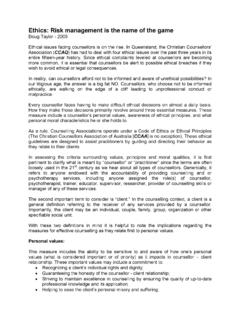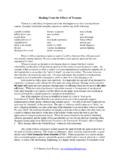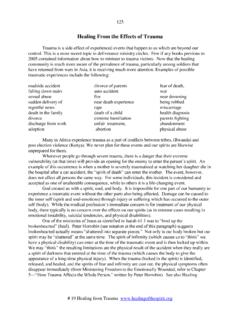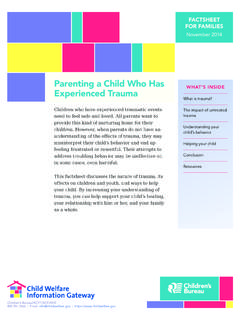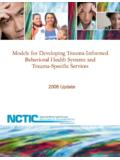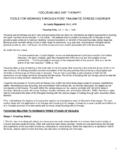Transcription of The effects of Trauma on Attachment
1 1 The effects of Trauma on Attachment Dr Graham A Barker Secure and stable relationships are the foundation for healthy emotional development and subsequent secure and stable relationships. Trauma related experiences (particularly in childhood), undermine attachments, thereby creating a cycle of further Trauma , intra psychic distress and alienation from sources of support. But first we need to outline our Foundational Concepts. Attachment Attachment is the emotional bond that is formed between objects in order to establish a sense of security and safety. The prototype of Attachment is the mother infant emotional bond. Attachment relationships provide: A safe haven that promotes a feeling of security even in times of distress. A secure base that fosters confidence in one s ability to actively explore the wider world. A structured schema that promotes the ability to make sense of mental states such as desires, feelings, and beliefs in oneself and others.
2 Although Attachment begins in infancy, the need for Attachment relationships continues throughout all life. Attachment theory began to take shape in the 50 s with the work of English psychiatrist, John Bowlby, and American psychologist, Mary Ainsworth. Attachment theory is based on the belief that the mother child (or caretaker) bond is the primary force in infant development. Bowlby s premise was that the relationship between infant and the primary caretaker is responsible for: shaping all future relationships shaping our ability to focus, an awareness of our feelings an ability to calm ourselves and the ability to rebound from misfortune Bowlby distinguished four patterns of Attachment : Secure Attachment Secure Attachment , like Erikson s basic trust, entails a sense of confidence that an Attachment object will be responsive when needed in times of distress. The form of Attachment will establish the template with which a child will construct: his future relationships with others her sense of security about exploring the world his resilience to stress her ability to balance her emotions, make sense of her life, and create meaningful2 interpersonal relationships.
3 A secure Attachment will provide the best foundation for these developments. Avoidant Attachment Avoidant Attachment describes that form of relationship where the child decides it is fruitless to rely upon others to meet his Attachment needs and attempts to meet them himself. If the parent is unavailable or rejecting, the child can get lost in her own inner world and avoid emotional connection. As an adult she may appear physically and emotionally distant in relationships. She is used to, and more comfortable with, distance and separateness and may therefore appear self centered and unresponsive to other people s needs. Ambivalent Attachment The ambivalent Attachment pattern involves an erratic emotional clinging accompanied by frustration and resentment. When the child experiences the parent as inconsistent or intrusive, she will often become anxious and fearful, never knowing what to expect. Subsequently as an adult she may be available one moment and rejecting the next.
4 She may love to argue, but rarely reach a resolution and her deep insecurity may fan her need to over attach. Disorganized Attachment The disorganized Attachment pattern is characterized by the fear of relationships and an inability to develop a workable strategy for interacting with those objects to whom he is attracted. When his need for emotional closeness remains unseen or ignored and the parent s behaviour is erratic and unpredictable, he often becomes disoriented, disorganized and aggressive. He will often have difficulty in regulating emotions, in reading social cues, in academic reasoning, and severe emotional problems. As an adult he may not give love and affection easily and may be unresponsive and insensitive to his partner s needs. He may also become enraged and abusive when he senses their inconsistency or emotional withdrawal. Although there is a basic life long need for secure attachments, these Attachment relationships undergo many changes in both object and intensity over the course of their development.
5 Attachment relationships may also develop with others such as siblings, extended family, teachers, friends, co workers, lovers, and pets. Developmental Timeline Attachment Differentiation/Separation Individuation Cohesion Integration Attachment is the first developmental task that the child consciously undertakes. The form of that Attachment lays down the template for the other tasks of Differentiation, Separation, Individuation and the internal structure of Evocative Object Constancy from which our sense of self emerges. Any disturbance in the completion of those tasks can leave the child with relational and self deficits Attachment therefore plays a key role in Trauma for two reasons:3 (1) Attachment relationships in the most critical time of the child s development can be a source of significant Trauma . (2) An Attachment relationship can restore the feeling of safety when there has been a potentially traumatic event. Trauma Trauma refers to the condition whereby an individual experiences a cluster of sever negative effects as a result of extremely stressful events.
6 These negative effects may include relational and behaviour problems and psychological disorders such as depression, anxiety, dissociation and posttraumatic stress. Potentially traumatic events include an objective experience such as witnessing a life threatening event, and a subjective experience such as feeling helpless and terrified that you re about to be killed. Whether or not exposure to potentially traumatic events results in persistent negative effects often depends on whether the victim has sufficient emotional structure (Object Constancy) to accommodate the event into her schemata and the support and comfort to restore a sense of safety amid the helpless and loneliness of personal Trauma . Potentially traumatic events range from a single incident (a car accident) to repeated stress (refugee Trauma ). It is possible to distinguish among three levels of involvement in potentially traumatic events: impersonal ( , a tornado), interpersonal ( , an assault), and Attachment Trauma ( , Trauma in Attachment relationships).
7 Attachment Trauma includes physical, sexual and psychological abuse and emotional and physical neglect related to relationships. Attachment Trauma in childhood may be especially problematic because of its influence on the course of psychological, social, emotional and physiological development over one s entire lifetime. The Attachment bonds formed between an infant and her primary caretaker profoundly influence both the structure and function of her developing brain. Failed Attachment , whether caused by caretaker abuse, neglect or emotional unavailability can negatively impact brain structure and function, causing developmental or relational Trauma . Early life Trauma affects future self esteem, social awareness, ability to learn and physical health. When the Attachment bond goes well, neurological integration develops normally, and relationship brings the expectation of safety, appreciation, joy and pleasure. If the Attachment bond was unsuccessful and traumatic, neurological impairment and memories of a failed relationship become the basis for adult expectations A person with a history of childhood Attachment Trauma may function very well for long periods into later life.
8 Yet relational stresses within adulthood will often expose the use by date of his childhood coping mechanisms and trigger a traumatic stress disorder. Neurological impairment, brought about by disabling experiences in the womb and at birth, is also traumatizing and interferes with the Attachment bond. Similar to the healing that can occur in adult victims when they find secure attachments, a good Attachment can help bring about neurological regulation in a moderately dysregulated Persons who have been traumatized in Attachment relationships rarely give up on attachments. Despite Trauma , most persons are able to establish and maintain some relatively secure attachments. The Neurology of Attachment Trauma Trauma is an experience that can transform a child s world into a terror filled, confusing miasma that dramatically alters his trajectory into and throughout adult life. Ultimately, it is the brain that processes and internalises traumatic experiences including Attachment Trauma .
9 It is the brain that mediates all emotional, cognitive, behavioral, social and physiological functioning. Understanding the organization, function and development of the human brain, and its responses to threat help us understand the traumatized child. The human brain is an amazingly complex organ comprised of over 100 billion neurons, all organized into networks that are interconnected into systems designed to sense, process, store, perceive, and respond to information from the external senses and the internal environment. Different systems in the brain mediate different functions: Systems in the frontal cortex are involved in abstract thought Systems in the brainstem are responsible for regulating heart rate, blood pressure and arousal states Systems in the limbic areas are responsible for Attachment , affect regulation and aspects of emotion and Systems in the cortex are responsible for abstract cognition and complex language.
10 Each of these systems varies somewhat with regard to function, neurotransmitter networks, synaptic structure, and regional localization. They all do however, obey similar molecular rules mediating development, changes in response to chemical signals, and storage of information. The single most significant distinguishing feature of all neurons is that they are designed to change in response to external signals. Those molecular changes permit the storage of information by neurons and neural systems. It is this capacity which allows the brain respond to the external and internal environment, and to allow the organism to differentiate, separate, individuate and integrate self and One important neurological principle is that all our experiences are filtered by our senses of sound, sight, taste, touch and smell that, in turn, initiate a cascade of neurochemistry and ultimately a change in brain structure and function. One function created by this process is the formation of our internal representations of the external world.
